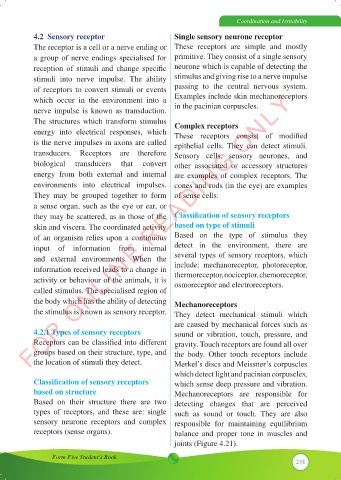Page 238 - Biology_F5
P. 238
Coordination and Irritability
4.2 Sensory receptor Single sensory neurone receptor
The receptor is a cell or a nerve ending or These receptors are simple and mostly
a group of nerve endings specialised for primitive. They consist of a single sensory
reception of stimuli and change specific neurone which is capable of detecting the
stimuli into nerve impulse. The ability stimulus and giving rise to a nerve impulse
of receptors to convert stimuli or events passing to the central nervous system.
FOR ONLINE READING ONLY
which occur in the environment into a Examples include skin mechanoreceptors
nerve impulse is known as transduction. in the pacinian corpuscles.
The structures which transform stimulus Complex receptors
energy into electrical responses, which These receptors consist of modified
is the nerve impulses in axons are called epithelial cells. They can detect stimuli.
transducers. Receptors are therefore Sensory cells, sensory neurones, and
biological transducers that convert other associated or accessory structures
energy from both external and internal are examples of complex receptors. The
environments into electrical impulses. cones and rods (in the eye) are examples
They may be grouped together to form of sense cells.
a sense organ, such as the eye or ear, or
they may be scattered, as in those of the Classification of sensory receptors
skin and viscera. The coordinated activity based on type of stimuli
of an organism relies upon a continuous Based on the type of stimulus they
input of information from internal detect in the environment, there are
and external environments. When the several types of sensory receptors, which
information received leads to a change in include: mechanoreceptor, photoreceptor,
thermoreceptor, nociceptor, chemoreceptor,
activity or behaviour of the animals, it is osmoreceptor and electroreceptors.
called stimulus. The specialised region of
the body which has the ability of detecting Mechanoreceptors
the stimulus is known as sensory receptor. They detect mechanical stimuli which
are caused by mechanical forces such as
4.2.1 Types of sensory receptors sound or vibration, touch, pressure, and
Receptors can be classified into different gravity. Touch receptors are found all over
groups based on their structure, type, and the body. Other touch receptors include
the location of stimuli they detect. Merkel’s discs and Meissner’s corpuscles
which detect light and pacinian corpuscles,
Classification of sensory receptors which sense deep pressure and vibration.
based on structure Mechanoreceptors are responsible for
Based on their structure there are two detecting changes that are perceived
types of receptors, and these are: single such as sound or touch. They are also
sensory neurone receptors and complex responsible for maintaining equilibrium
receptors (sense organs). balance and proper tone in muscles and
joints (Figure 4.21).
Form Five Student’s Book
231

